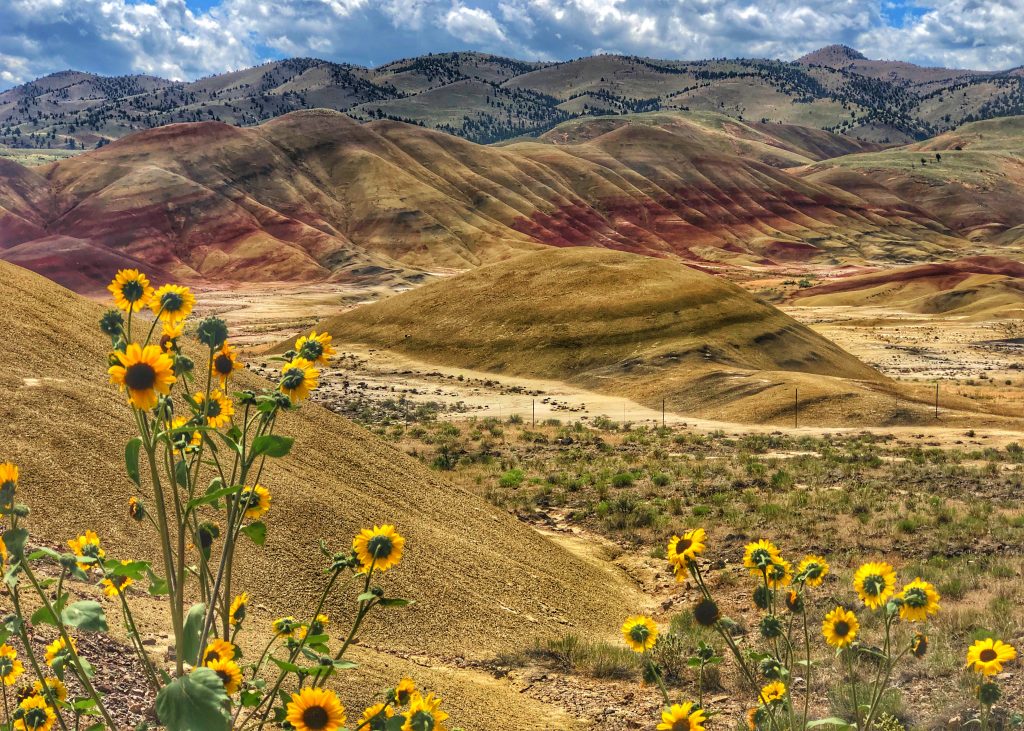A tale of two landscapes by Ian Madin
Ian Madin worked as a geologist with the Oregon Department of Geology and Mineral Industries for 32 years and has ridden with Cycle Oregon for over a decade now. His nightly presentations at Classic reveal the cool and sometimes hidden geology of the regions through which we ride. Stay tuned to the blog for this series as Ian takes us day by day through this wonderous region.

Cycle Oregon Classic XXXII traverses one of the most geologically diverse and colorful parts of Oregon, and although the valleys, hills and cliffs we will pass seem endlessly varied, there are mainly just two geologic landscapes. If you had arrived in this area 15 million years ago, you would have seen an endless plain of fresh lava, the result of dozens of monumental eruptions of the Columbia River basalt, but buried beneath those hundreds of feet of dense black rock was an earlier landscape, one that had been in place from the end of the era of the dinosaurs. Geologists call this kind of abrupt transition of rock types and geologic environments an unconformity, because the rocks above do not conform to previous layers. Since the basalt eruptions ceased, a new landscape has been forming as erosion eats through the armor of basalt to expose the older world beneath. Our ride will take us back and forth between these two worlds, across the unconformity.

For most of the ride we will be seeing either the Columbia River basalt, with its characteristic cliffs of dark rock, or the older John Day and Clarno formations which are a mixture of lava flows, lake sediments, and volcanic ash that were deposited on land. Most sedimentary rocks that preserve fossils are deposited in the ocean, rather than on land, because the land surface is usually in a state of constant erosion and change. As a result, fossil deposits from the land are rare and there are usually large gaps in time between them. The John Day formation is very unusual because it contains a continuous record of land animals spanning most of the age of mammals, starting shortly after the great extinction of the dinosaurs 76 million years ago and extending to the eruption of the Columbia River basalt 16 million years ago. The ash layers in the John Day rocks can be precisely dated using radioactive decay analysis, so it is possible to develop a continuous history of the evolution of many important groups of mammals.
When the Columbia River basalt lava flows began to pour out of giant fissures in the earth along the Oregon-Idaho-Washington border, they encountered a varied landscape eroded into the John Day rocks, with mountains and deep canyons. The early flows filled in the canyons and valleys, and as the flows continued for hundreds of thousands of years, the older landscape was completely buried. Erosion since the end of the eruptions has carved new canyons through the basalt to reveal the John Day rocks beneath.
Although these two types of rock make up most of the route, we will also see even more ancient rocks of exotic terranes transported here by plate tectonics, sandstone and cemented gravel from the oceans at the time of the dinosaurs, and the remnants of an enormous volcanic explosion that covered half of eastern Oregon with glowing ash. The landscape is still active and we will pass by huge landslides and active earthquake faults.
Buckle your helmets, we are in for some wild geology!
These are great!
I often get questions about what potential Classic riders might expect on a CO trip, but it falls flat when I tell them it is different each year.
These are brilliant and informative descriptions of the ride and the land around it. Keep them coming.
Thanks Ian for your details and enthusiasm (as usual.)
Thank you for the informative article. Sounds amazing!
Wow! — This information is really great, and I can’t wait to learn more! A key learning point for me was that “most sedimentary rocks that preserve fossils are deposited in the ocean…” Your explanation makes total sense.
One question: you refer to “…the great extinction of the dinosaurs 76 million years ago…” and I thought that extinction event was around 66MYA. Is my timing off? (I’m often late, but not by 10 million years.)